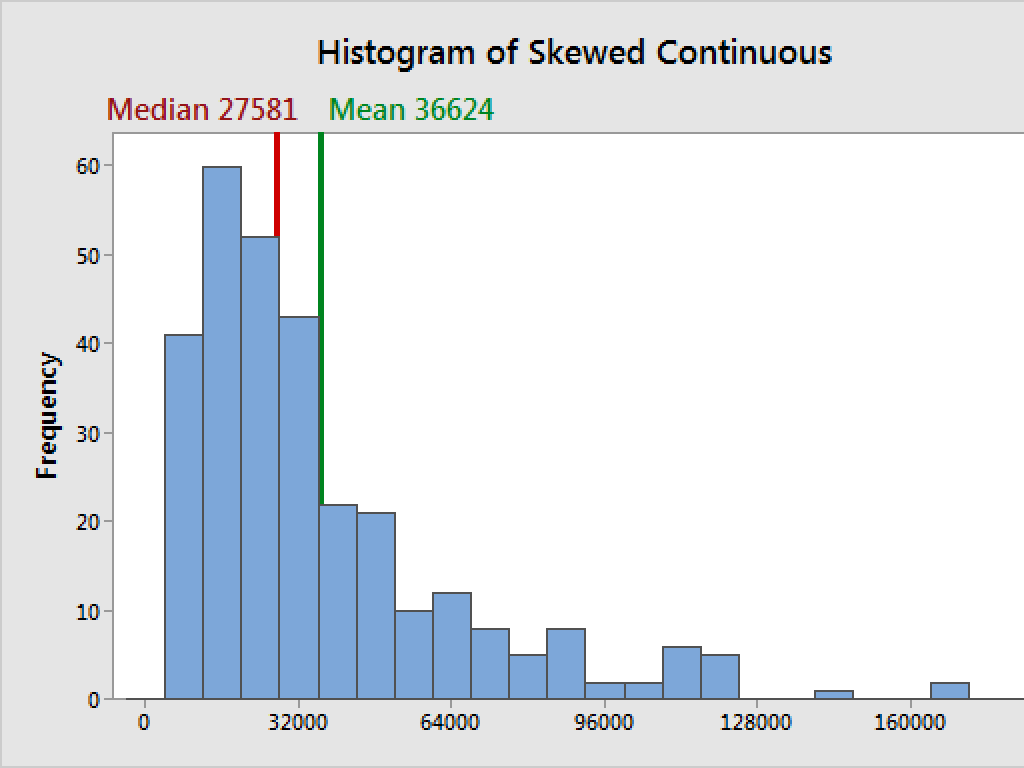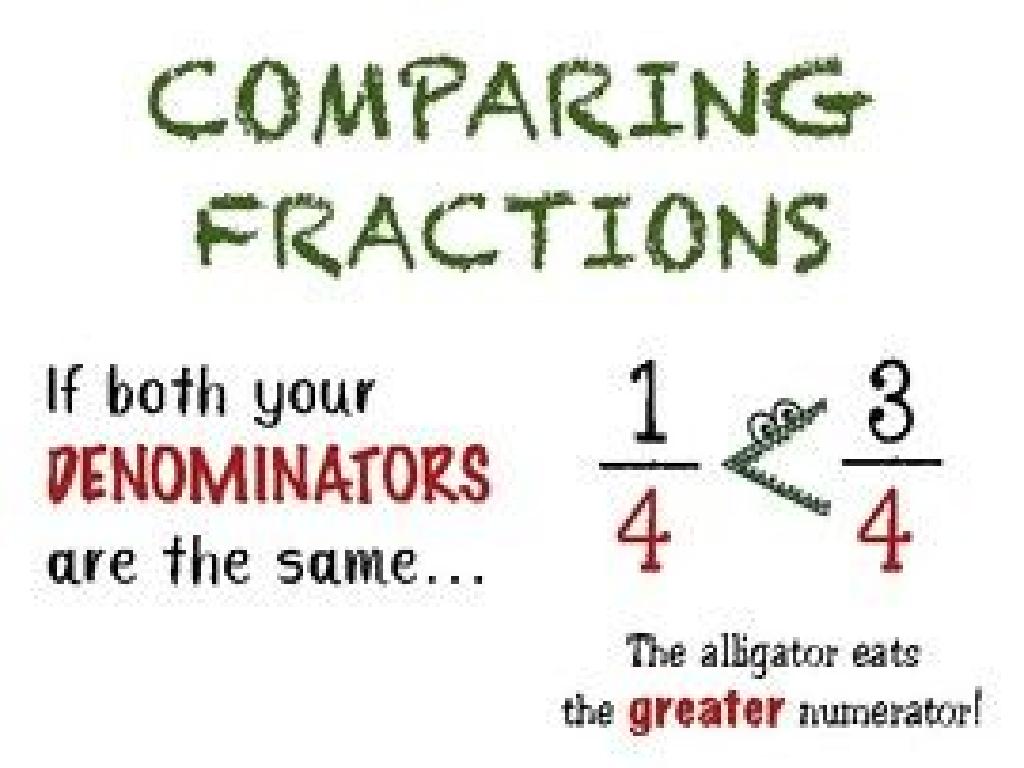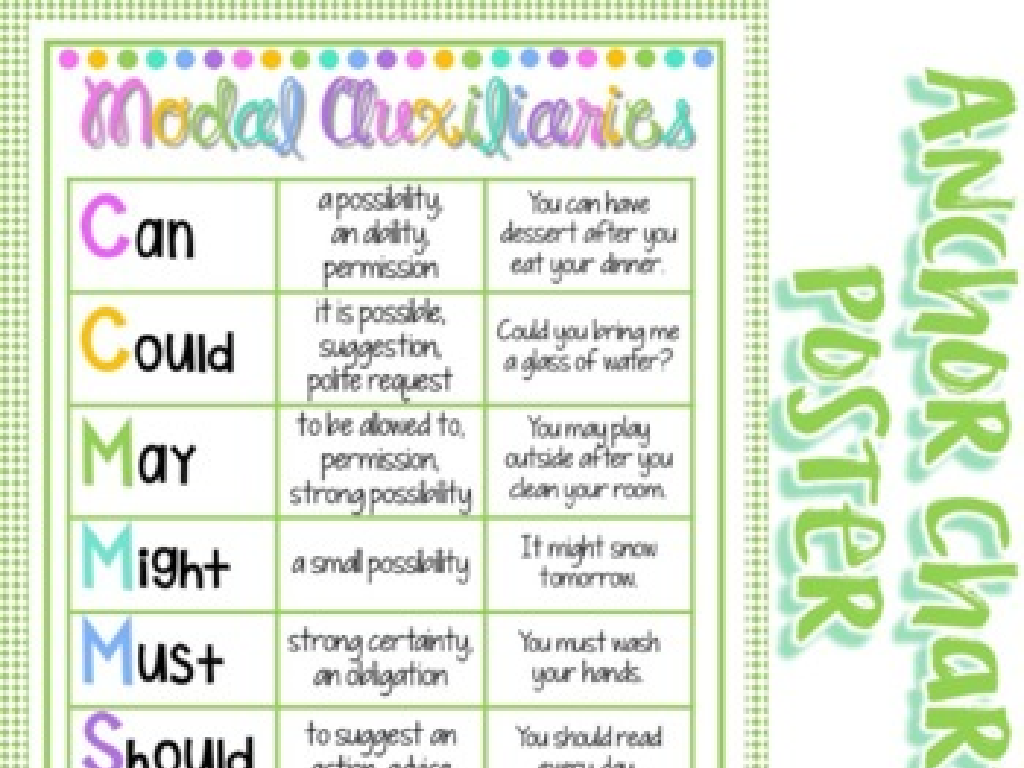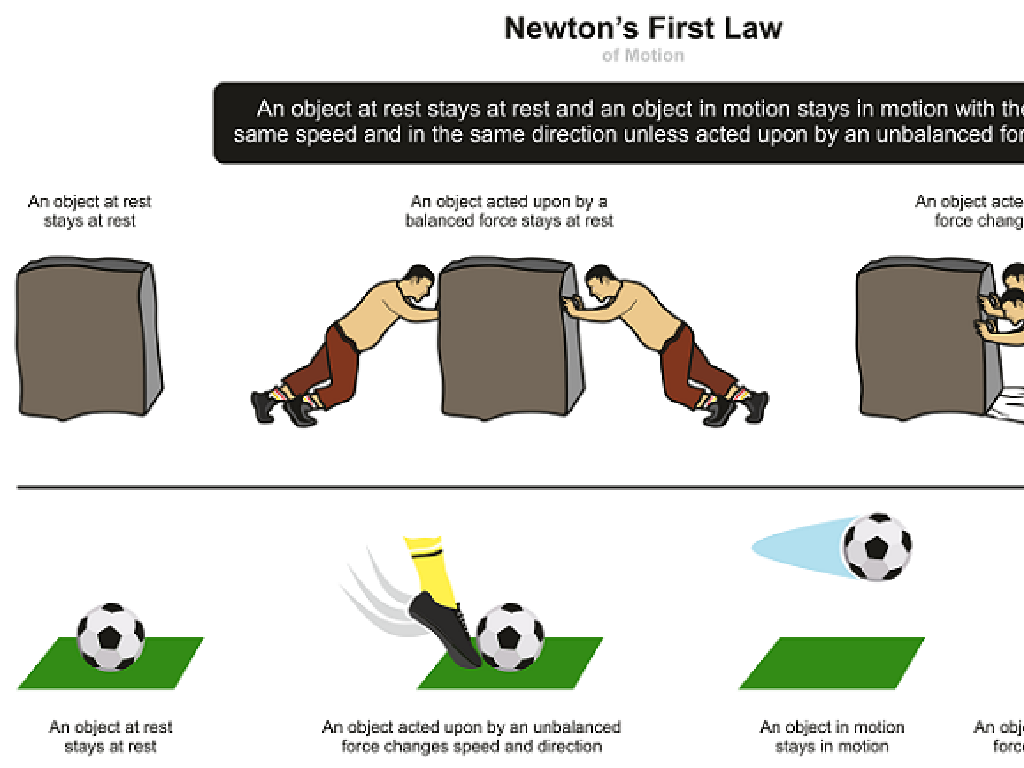Make Thirds
Subject: Math
Grade: Second grade
Topic: Fractions
Please LOG IN to download the presentation. Access is available to registered users only.
View More Content
Welcome to Fractions: Making Thirds
– Fractions represent parts
– Whole things can be divided
– Like sharing a pizza equally
– Making thirds means 3 equal parts
– Divide a shape into 3 equal slices
– Each part is one third of a whole
– 1/3 is one slice of the divided shape
|
This slide introduces the concept of fractions to second graders, focusing on the idea of ‘thirds.’ Begin by explaining that fractions are a way to represent parts of a whole item or group. Use tangible examples like dividing a pizza or a chocolate bar to illustrate the concept of equal parts. Emphasize that ‘making thirds’ means dividing something into three equal sections, and each section is called ‘one third.’ Use visual aids like pictures or actual objects to show this division. Encourage students to think of other items that can be divided into thirds to help solidify their understanding.
Understanding Fractions: Making Thirds
– Fractions show parts of a whole
– Top number is the numerator
– The numerator counts how many parts we have
– Bottom number is the denominator
– Denominator shows equal parts
– For thirds, the denominator is 3
|
This slide introduces the concept of fractions to second-grade students, focusing on ‘thirds’ as a specific example. Begin by explaining that fractions are a way to represent parts of a whole item or set. The top number, or numerator, indicates how many parts of the whole we are considering. The bottom number, or denominator, tells us into how many equal parts the whole is divided. For making thirds, the denominator will always be 3, which means the whole is divided into three equal parts. Use visual aids like pie charts or divided objects to help students visualize the concept. Encourage students to think of examples of dividing things into thirds, such as cutting a pizza or sharing treats with two friends.
Understanding Thirds
– Dividing into 3 equal parts
– Imagine cutting a pizza into 3 same size slices.
– Each part is one third
– If you take one slice, that’s one third of the pizza.
– One third as a fraction
– We write this part as 1/3.
– Recognizing thirds
– Look at objects divided into 3 pieces.
|
This slide introduces the concept of thirds to second-grade students. Begin by explaining that when we divide something into three equal parts, each part is called a third. Use tangible examples like cutting a pizza or an apple into three pieces to illustrate this point. Show them that the fraction 1/3 represents one of these parts. Use visual aids like pictures or actual objects to help students recognize and understand thirds in different contexts. Encourage them to think of other items that can be divided into thirds and to practice writing the fraction 1/3.
Making Thirds with Shapes
– Dividing shapes into thirds
– Split shapes into 3 equal parts
– Thirds in circles and rectangles
– For a circle, cut like a ‘peace’ sign; for a rectangle, 3 equal columns
– Equal-sized thirds
– Each part must be the same size to be a third
|
This slide introduces the concept of dividing shapes into thirds, which is a fundamental skill in understanding fractions. Emphasize that when we make thirds, we are splitting the shape into three equal parts. Use concrete examples like cutting a pie (circle) or a chocolate bar (rectangle) to help students visualize the concept. Demonstrate how to divide different shapes into thirds, ensuring that each part is equal in size. This can be done by drawing lines or using physical models. Encourage students to practice with paper and scissors or drawing tools to create their own thirds. Reinforce the idea that all three parts must be equal to be considered thirds, which is crucial for their understanding of equal parts in fractions.
Making Thirds with Objects
– Dividing objects into thirds
– Visualize cutting a candy bar
– Imagine splitting it into 3 equal parts
– Each piece is one third
– One of those parts is called a third
– Equal pieces are important
– All pieces must be the same size
|
This slide is aimed at helping second-grade students understand the concept of dividing objects into thirds. Start by explaining that when we divide something into three equal parts, each part is called a third. Use tangible examples like a candy bar or an apple, as these are items children are familiar with and can easily visualize. Emphasize the importance of making the pieces equal, as this is a crucial aspect of creating thirds. During the lesson, consider bringing in actual objects to demonstrate this concept or use cut-outs and drawings for a visual representation. Encourage the students to think of other objects they could divide into thirds and why it might be useful to do so.
Understanding Thirds in Everyday Life
– Finding thirds around us
– Look for objects that can be divided into 3 equal parts, like a pizza.
– Sharing equally with friends
– If you have 3 cookies, how can you share them with 2 friends so everyone gets the same amount?
– Using thirds in recipes
– Some recipes ask for 1/3 cup of an ingredient. That’s one part out of three equal parts!
– Practice with real objects
– Use items like fruits to physically divide and understand thirds.
|
This slide aims to help students recognize and make thirds in contexts they are familiar with. Start by discussing how many items in their environment can be divided into three equal parts, such as a pizza or a cake. Emphasize the concept of fairness in sharing by giving examples of dividing treats among friends. Introduce the idea of measuring ingredients in thirds to help them relate to portions and recipes. Encourage hands-on practice with real objects to solidify their understanding. This tactile experience is crucial for second graders as it helps them visualize and grasp the concept of fractions in a concrete way.
Let’s Practice Making Thirds!
– Class activity with playdough or paper
– Each student gets equal material
– Divide material into 3 equal parts
– Make sure each part is the same size
– Create your own thirds
– Show your thirds to the class
|
This slide introduces a hands-on class activity to help students understand the concept of dividing objects into thirds. Provide each student with an equal amount of playdough or paper. Guide them to divide their material into three equal parts, emphasizing the importance of making each part the same size to represent thirds accurately. Encourage creativity in how they divide the material. After the activity, ask students to present their divided thirds to the class, fostering a discussion about the equality of each part. Possible variations of the activity could include using different materials or shapes, working in pairs, or challenging students to find objects in the classroom that can be divided into thirds.
Review: Understanding Thirds
– Recap on thirds concept
– Demonstrate 1/3 of an object
– Use items like an apple or a pizza
– Equal parts in thirds
– Each of the 3 parts must be the same size
– Class participation
|
This slide aims to review the concept of thirds that was taught in the class. Start by asking the students what they remember about thirds. Encourage them to demonstrate by showing 1/3 of an object, which could be anything that can be divided into three equal parts, like an apple or a pizza. Reinforce the idea that when we make thirds, all three parts must be equal in size. This is a fundamental concept in understanding fractions. Engage the class by asking volunteers to come up and show 1/3 of various objects. This interactive recap will help solidify their understanding of fractions as parts of a whole.
Conclusion: Understanding Thirds
– Excellent work on thirds!
– Homework: Find 3 objects
– Look for items like pizza or pie
– Make and illustrate thirds
– Draw or photograph your divided objects
– Show your thirds in class
|
Today’s lesson focused on understanding and making thirds, which is a fundamental concept in learning fractions. For homework, students are encouraged to apply this knowledge practically by finding objects around their home that they can divide into thirds. This could be food items or any other objects that can be easily and safely split into three equal parts. They should either draw these divided items or take pictures to bring to class for discussion. This activity will help reinforce their understanding of fractions and thirds, and sharing their findings will allow for a collaborative learning experience. Remember to remind students to ask for help from an adult if necessary, especially when dividing objects that might require cutting or breaking.





